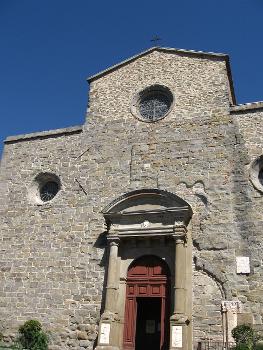General Information
| Status: | in use |
|---|
Project Type
| Function / usage: |
Church |
|---|
Location
Technical Information
There currently is no technical data available.
Excerpt from Wikipedia
Cortona Cathedral (Italian:Duomo di Cortona, Concattedrale di Santa Maria Assunta) is a Roman Catholic cathedral in Cortona, Tuscany, central Italy, dedicated to the Assumption of the Blessed Virgin Mary. It was the seat of the Bishops of Cortona from 1507 to 1986, and is now a co-cathedral in the present Diocese of Arezzo-Cortona-Sansepolcro.
History
The church was built over the remains of an ancient Roman temple and is mentioned (as a pieve, or plebeian church) in the 11th century. In 1325 the diocese of Cortona was created from the territory of the diocese of Arezzo, but the present cathedral was not chosen at that date as the episcopal seat, although the adjoining building was used as the bishop's residence.
In 1507 Pope Julius II resolved the anomaly and transferred the bishop's seat from the sub-urban church of San Vincenzo. As if in preparation for ist new importance, the interior had been refurbished in the late 15th century.
Description
The appearance of the original medieval church is mostly hidden by later additions, such as the 18th century barrel vaulted ceiling in the nave, which was repainted in the late 19th century by the local artist Giovanni Brunacci; in the same period the oval windows, the triumphal arch and the pavement were also added or remade. The oldest elements visible are in the Romanesque façade - a pier with capital, and small columns at the corners, and part of the large arcade.
The church has a central nave and two aisles, divided by columns with Brunelleschi-inspired capitals. The south side has a loggia built in the late 16th century. The bell tower dates from the middle of the same century.
Artworks in the interior include an Adoration of the Shepherds by Pietro da Cortona and assistants (c. 1663), a Consecration of the Church of the Holy Saviour by Andrea Commodi (1607, brought here in the late 18th century) and a Descent of the Holy Spirit by Tommaso Bernabei (1528-1529). The town's Diocesan Museum houses works formerly in the cathedral, including Pietro Lorenzetti's Maestà (before 1320), and a tapestry and a reliquary from the period of the Renaissance.
Text imported from Wikipedia article "Cortona Cathedral" and modified on July 23, 2019 according to the CC-BY-SA 4.0 International license.
Participants
Currently there is no information available about persons or companies having participated in this project.
Relevant Web Sites
- About this
data sheet - Structure-ID
20035631 - Published on:
20/03/2008 - Last updated on:
02/03/2020





